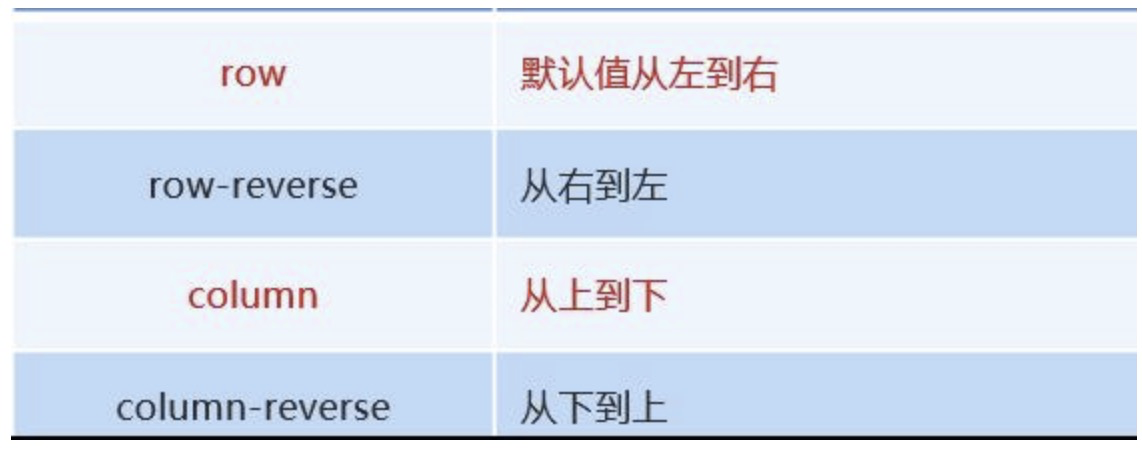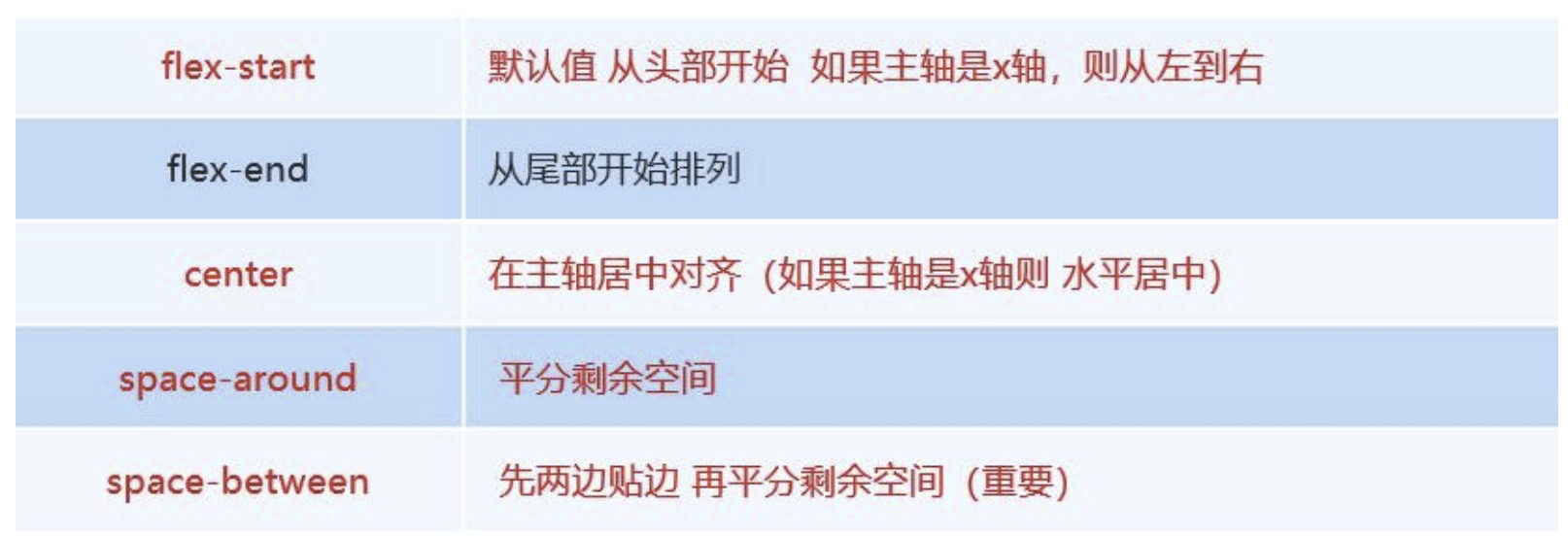移动flex布局
移动web开发——flex布局
1.0传统布局和flex布局对比
1.1传统布局
- 兼容性好
- 布局繁琐
- 局限性,不能再移动端很好的布局
1.2 flex布局
-
操作方便,布局极其简单,移动端使用比较广泛
-
pc端浏览器支持情况比较差
-
IE11或更低版本不支持flex或仅支持部分
<!DOCTYPE html> <html lang="en"> <head> <meta charset="UTF-8"> <meta name="viewport" content="width=device-width, initial-scale=1.0"> <meta http-equiv="X-UA-Compatible" content="ie=edge"> <title>flex体验布局</title> <style> div { display: flex; width: 80%; height: 300px; background-color: pink; justify-content: space-around; } div span { /* width: 150px; */ height: 100px; background-color: purple; margin-right: 5px; flex: 1; } </style> </head> <body> <div> <span>1</span> <span>2</span> <span>3</span> </div> </body> </html>
1.3 建议
- 如果是pc端页面布局,还是采用传统方式
- 如果是移动端或者是不考虑兼容的pc则采用flex
2.0 flex布局原理
- flex 是 flexible Box 的缩写,意为"弹性布局",用来为盒状模型提供最大的灵活性,任何一个容器都可以指定为 flex 布局。
- 当我们为父盒子设为 flex 布局以后,子元素的 float、clear 和 vertical-align 属性将失效。
- flex布局又叫伸缩布局 、弹性布局 、伸缩盒布局 、弹性盒布局
- 采用 Flex 布局的元素,称为 Flex 容器(flex
container),简称"容器"。它的所有子元素自动成为容器成员,称为 Flex 项目(flex
item),简称"项目"。
总结:就是通过给父盒子添加flex属性,来控制子盒子的位置和排列方式
3.0 父项常见属性
- flex-direction:设置主轴的方向
- justify-content:设置主轴上的子元素排列方式
- flex-wrap:设置子元素是否换行
- align-content:设置侧轴上的子元素的排列方式(多行)
- align-items:设置侧轴上的子元素排列方式(单行)
- flex-flow:复合属性,相当于同时设置了 flex-direction 和 flex-wrap
3.1 flex-direction设置主轴的方向
-
在 flex 布局中,是分为主轴和侧轴两个方向,同样的叫法有 : 行和列、x 轴和y 轴
-
默认主轴方向就是 x 轴方向,水平向右
-
默认侧轴方向就是 y 轴方向,水平向下
-
注意: 主轴和侧轴是会变化的,就看 flex-direction 设置谁为主轴,剩下的就是侧轴。而我们的子元素是跟着主轴来排列的

- 实例
<!DOCTYPE html> <html lang="en"> <head> <meta charset="UTF-8"> <meta name="viewport" content="width=device-width, initial-scale=1.0"> <meta http-equiv="X-UA-Compatible" content="ie=edge"> <title>Document</title> <style> div { /* 给父级添加flex属性 */ display: flex; width: 800px; height: 300px; background-color: pink; /* 默认的主轴是 x 轴 行 row 那么y轴就是侧轴喽 */ /* 我们的元素是跟着主轴来排列的 */ /* flex-direction: row;*/ /* 简单了解 翻转 */ /* flex-direction: row-reverse;*/ /* 我们可以把我们的主轴设置为 y轴 那么 x 轴就成了侧轴 */ flex-direction: column; } div span { width: 150px; height: 100px; background-color: purple; } </style> </head> <body> <div> <span>1</span> <span>2</span> <span>3</span> </div> </body> </html>
3.2 justify-content 设置主轴上的子元素排列方式

-
实例
<!DOCTYPE html> <html lang="en"> <head> <meta charset="UTF-8"> <meta name="viewport" content="width=device-width, initial-scale=1.0"> <meta http-equiv="X-UA-Compatible" content="ie=edge"> <title>Document</title> <style> div { display: flex; width: 800px; height: 300px; background-color: pink; /* 默认的主轴是 x 轴 row */ flex-direction: row; /* justify-content: 是设置主轴上子元素的排列方式 */ /* justify-content: flex-start;*/ /* justify-content: flex-end;*/ /* 让我们子元素居中对齐 */ /* justify-content: center;*/ /* 平分剩余空间 */ /* justify-content: space-around;*/ /* 先两边贴边, 在分配剩余的空间 */ justify-content: space-between; } div span { width: 150px; height: 100px; background-color: purple; } </style> </head> <body> <div> <span>1</span> <span>2</span> <span>3</span> <span>4</span> </div> </body> </html>
3.3 flex-wrap设置是否换行
-
默认情况下,项目都排在一条线(又称”轴线”)上。flex-wrap属性定义,flex布局中默认是不换行的。
-
nowrap 不换行
-
wrap 换行
-
实例
<!DOCTYPE html> <html lang="en"> <head> <meta charset="UTF-8"> <meta name="viewport" content="width=device-width, initial-scale=1.0"> <meta http-equiv="X-UA-Compatible" content="ie=edge"> <title>Document</title> <style> div { display: flex; width: 600px; height: 400px; background-color: pink; /* flex布局中,默认的子元素是不换行的, 如果装不开,会缩小子元素的宽度,放到父元素里面 */ /* flex-wrap: nowrap;*/ flex-wrap: wrap; } div span { width: 150px; height: 100px; background-color: purple; color: #fff; margin: 10px; } </style> </head> <body> <div> <span>1</span> <span>2</span> <span>3</span> <span>4</span> <span>5</span> </div> </body> </html>
-
3.4 align-items 设置侧轴上的子元素排列方式(单行 )
- 该属性是控制子项在侧轴(默认是y轴)上的排列方式 在子项为单项(单行)的时候使用
- flex-start 从头部开始
- flex-end 从尾部开始
- center 居中显示
- stretch 拉伸
3.5 align-content 设置侧轴上的子元素的排列方式(多行)
设置子项在侧轴上的排列方式 并且只能用于子项出现 换行 的情况(多行),在单行下是没有效果的。

-
实例
<!DOCTYPE html> <html lang="en"> <head> <meta charset="UTF-8"> <meta name="viewport" content="width=device-width, initial-scale=1.0"> <meta http-equiv="X-UA-Compatible" content="ie=edge"> <title>Document</title> <style> div { display: flex; width: 800px; height: 400px; background-color: pink; /* 换行 */ flex-wrap: wrap; /* 因为有了换行,此时我们侧轴上控制子元素的对齐方式我们用 align-content */ /* align-content: flex-start;*/ /* align-content: center;*/ /* align-content: space-between;*/ align-content: space-around; } div span { width: 150px; height: 100px; background-color: purple; color: #fff; margin: 10px; } </style> </head> <body> <div> <span>1</span> <span>2</span> <span>3</span> <span>4</span> <span>5</span> <span>6</span> </div> </body> </html>
3.6 align-content 和align-items区别
- align-items 适用于单行情况下, 只有上对齐、下对齐、居中和 拉伸
- align-content适应于换行(多行)的情况下(单行情况下无效), 可以设置 上对齐、下对齐、居中、拉伸以及平均分配剩余空间等属性值。
- 总结就是单行找align-items 多行找 align-content
3.7 flex-flow 属性是 flex-direction 和 flex-wrap 属性的复合属性
flex-flow:row wrap;
4.0 flex布局子项常见属性
-
flex子项目占的份数
-
align-self控制子项自己在侧轴的排列方式
-
order属性定义子项的排列顺序(前后顺序)
-
实例
<!DOCTYPE html> <html lang="en"> <head> <meta charset="UTF-8"> <meta name="viewport" content="width=device-width, initial-scale=1.0"> <meta http-equiv="X-UA-Compatible" content="ie=edge"> <title>Document</title> <style> section { display: flex; width: 60%; height: 150px; background-color: pink; margin: 0 auto; } section div:nth-child(1) { width: 100px; height: 150px; background-color: red; } section div:nth-child(2) { flex: 1; background-color: green; } section div:nth-child(3) { width: 100px; height: 150px; background-color: blue; } p { display: flex; width: 60%; height: 150px; background-color: pink; margin: 100px auto; } p span { flex: 1; } p span:nth-child(2) { flex: 2; background-color: purple; } </style> </head> <body> <section> <div></div> <div></div> <div></div> </section> <p> <span>1</span> <span>2</span> <span>3</span> </p> </body> </html>
-
4.1 flex 属性
flex 属性定义子项目分配剩余空间,用flex来表示占多少份数。
.item {
flex: <number>; /* 默认值 0 */
}
4.2 align-self控制子项自己在侧轴上的排列方式
align-self 属性允许单个项目有与其他项目不一样的对齐方式,可覆盖 align-items 属性。
默认值为 auto,表示继承父元素的 align-items 属性,如果没有父元素,则等同于 stretch。
span:nth-child(2) {
/* 设置自己在侧轴上的排列方式 */
align-self: flex-end;
}
4.3 order 属性定义项目的排列顺序
数值越小,排列越靠前,默认为0。
注意:和 z-index 不一样。
.item {
order: <number>;
}
<!DOCTYPE html>
<html lang="en">
<head>
<meta charset="UTF-8">
<meta name="viewport" content="width=device-width, initial-scale=1.0">
<meta http-equiv="X-UA-Compatible" content="ie=edge">
<title>Document</title>
<style>
div {
display: flex;
width: 80%;
height: 300px;
background-color: pink;
/* 让三个子盒子沿着侧轴底侧对齐 */
/* align-items: flex-end; */
/* 我们想只让3号盒子下来底侧 */
}
div span {
width: 150px;
height: 100px;
background-color: purple;
margin-right: 5px;
}
div span:nth-child(2) {
/* 默认是0 -1比0小所以在前面 */
order: -1;
}
div span:nth-child(3) {
align-self: flex-end;
}
</style>
</head>
<body>
<div>
<span>1</span>
<span>2</span>
<span>3</span>
</div>
</body>
</html>
- 颜色渐变背景
<style>
div {
width: 600px;
height: 200px;
/* 背景渐变必须添加浏览器私有前缀 */
/* background: -webkit-linear-gradient(left, red, blue); */
/* background: -webkit-linear-gradient(red, blue); */
background: -webkit-linear-gradient(top left, red, blue);
}
</style>




